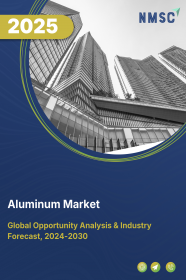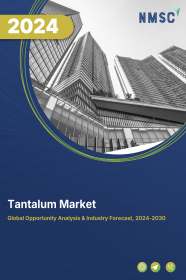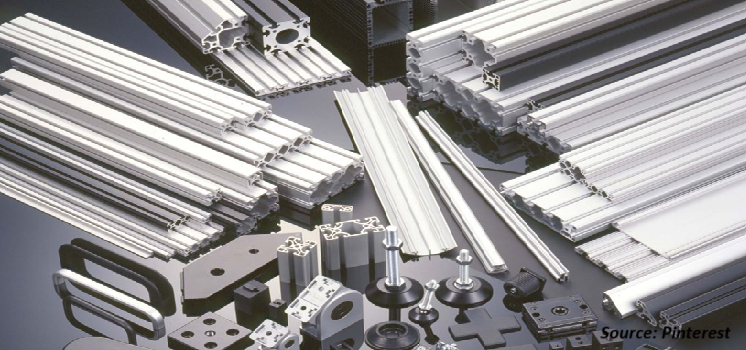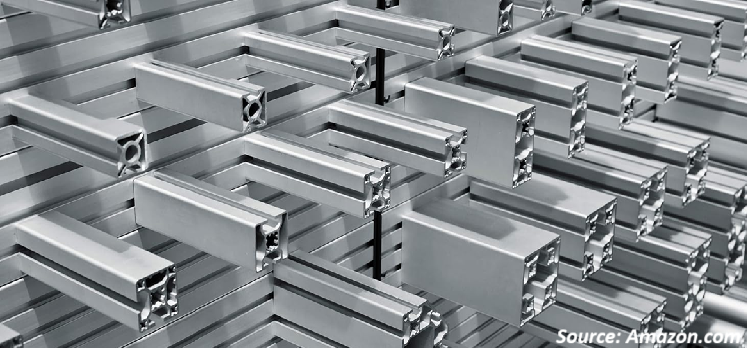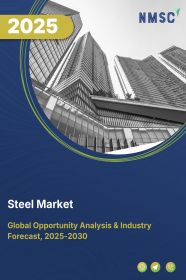
Steel Market by Product Type (Carbon Steel, Alloy Steel, Stainless Steel, Tool Steel, and Specialty Steels), by Form (Flat Steel, Long Steel, and Others), by Process (Basic Oxygen Furnace (BOF), Electric Arc Furnace, and Others), by Sustainability (Recycled Steel, Virgin Steel, and Green Steel), and by End User (Construction, Automotive, Oil & Gas, Manufacturing, Power Generation, Consumer Appliances, Aerospace & Defense, and Others) – Global Opportunity Analysis and Industry Forecast 2025-2030
US Tariff Impact on Steel Market
Trump Tariffs Are Reshaping Global Business
Steel Market Overview
The global Steel Market size was valued at USD 1.16 trillion in 2024 and it is projected to reach USD 1.46 trillion by 2030 with a CAGR of 3.8% from 2025-2030. The market is driven by factors including growing healthcare industry along with rising expenditure towards aerospace and defense industry and expanding automotive electronics industry. However, the market is restricted by the outrageous development cost.
The demand for steel continues to rise steadily, driven by a combination of infrastructure expansion, automotive sector growth, supportive government policies, and the emerging shift toward green steel production, although the industry simultaneously grapples with the challenge of reducing its substantial carbon footprint. Infrastructure development, particularly in rapidly growing economies like India, directly fuels steel consumption as large-scale construction projects require durable materials, while the automotive sector’s evolution especially the transition to electric vehicles sustains steel’s importance despite changes in material preferences. Government initiatives promoting sustainable practices and carbon neutrality are increasingly shaping industry strategies, incentivizing a shift toward greener production methods such as hydrogen-based steelmaking and renewable energy use. However, the need to drastically cut emissions remains a major restraint, requiring significant investments in low-carbon technologies and production overhauls. Despite this, the green transition opens up substantial opportunities, particularly for early adopters of innovative and eco-friendly methods, positioning them to capture emerging demand in a market that increasingly prioritizes sustainability alongside performance.
Rising Infrastructure Development Boosts the Demand for Steel Consumption
The symbiotic relationship between infrastructure development and steel demand is a fundamental driver shaping the trajectory of the global industry size and its market growth potential. India's ambitious infrastructure projects, bolstered by significant government spending, exemplify this trend, propelling the nation into a phase of considerable market growth.
The Indian Steel Association (ISA) anticipates a rise in product requirements, reaching 128.9 million tonnes in the 2023-24 period, up from 119.9 million tonnes in the preceding year. Furthermore, domestic demand in India is estimated to grow by 9-10% in FY25. This robust demand underscores how infrastructure development acts as a primary engine for the market, influencing its market size and offering considerable growth potential for industry players like Captain Steel India Limited.
Globally, steel has long been valued for its strength and durability, making it indispensable for building bridges, railroads, ships, and skyscrapers, directly linking societal advancement with steel consumption.
Growth of Automotive Sector Consistent Fuels the Market Growth
The growing automotive sector represents another steady and reliable driver for global market growth. As the automotive industry undergoes a significant upheaval driven by trends like diverse mobility, autonomous driving, electrification, and connectivity, the demand for steel, a crucial material in vehicle manufacturing will remain strong.
While the automotive sector is shifting towards electric vehicles, which might alter the specific types and quantities of materials needed, steel will continue to be a fundamental component. This sustained need from a major industrial consumer ensures a baseline market size and offers predictable growth potential for steel manufacturers. To fully capitalise on this, however, the industry will likely need to further adopt climate-friendly processes to align with the sustainability focus of the evolving automotive sector.
Government Policies Catalysing the Demand for Steel
Government policies and initiatives are playing an increasingly vital role in driving the steel industry towards green production and sustainability. For instance, the Ministry of Steel in India is actively promoting this transition, hosting events like ‘Greening Steel: Pathway to Sustainability’ and releasing comprehensive reports such as "Greening the Steel Sector in India: Roadmap and Action Plan". These efforts, driven by India’s commitment to achieving net-zero carbon emissions, outline strategies like energy efficiency, renewable energy use, green hydrogen, and biochar to facilitate the shift to sustainable steel production.
Financial facilitation, policy frameworks, and industry collaboration are deemed essential for achieving these ambitious sustainability goals, aiming for net-zero emissions by 2070. Such governmental focus not only sets the direction for the industry but also creates opportunities for market share gains for companies that proactively adopt green steel technologies and align with these policy objectives.
Need for Emission Reduction Acts as a Major Restraint for the Market Growth
The steel industry stands as one of the world’s most polluting sectors, accounting for roughly 7% of global carbon dioxide emissions. This significant environmental footprint presents a major restraint and challenge for the industry as global pressure intensifies to decarbonise activities and meet the goals of The Paris Agreement.
The imperative to transition from traditional, coal-based production methods to green steel technologies is crucial. This transition necessitates substantial investment in new technologies and processes that do not emit carbon dioxide, such as modifying technology routes (Blast Furnace (BF) to Direct Reduced Iron/Electric Arc Furnace (DRI/EAF)), renewable energy transition, and alternative fuels like green hydrogen.
Failure to address these high carbon emissions not only risks environmental repercussions but also potential regulatory penalties and loss of market share as consumers and industries increasingly favour sustainable materials.
The Transition to Green Steel Presents Lucrative Opportunity for the Steel Market Growth
The transition to green steel production presents a significant opportunity for the steel industry players to not only mitigate their environmental impact but also to establish themselves as leaders in a rapidly evolving market.
The Middle East & North Africa (MENA) region, for instance, has the potential to become a leader in this global transition, leveraging its existing gas-based direct reduced iron (DRI) production which can be adapted to use green hydrogen for further emission reductions.
For instance, in October 2024, EMSTEEL and Masdar, both UAE-based companies, launched the MENA region’s first green hydrogen-based steel pilot project in Abu Dhabi, producing certified green steel and aligning with the UAE’s Net Zero by 2050 Strategy. This follows Boston Metal’s electrochemical steelmaking technology announcement in April 2025, which uses electricity to produce steel without coal, potentially reducing annual carbon emissions by 3 billion tons.
The development and adoption of low-carbon technologies, including carbon capture utilisation and storage (CCUS), renewable energy integration, and hydrogen-based steelmaking, offer pathways to reduce carbon emissions and create new market opportunities.
Companies that invest early in these green technologies and sustainable practices can gain a competitive edge, attract environmentally conscious customers, and potentially benefit from government incentives aimed at promoting green industries, ultimately enhancing their market position and long-term sustainability within the global steel sector.
Market Segmentation and Scope of the Study
The steel market report is divided on the basis of product type, form, process, sustainability, end user, and region. On the basis of product type, the market is segmented into carbon steel, alloy steel, stainless steel, tool steel, and specialty steel. Carbon steel is further divided into low carbon steel, medium carbon steel, and high carbon steel. Alloy steel is further segmented into low-alloy steel high-alloy steel. Specialty steel is further classified into electrical steel and bearing steel. On the basis of form, the market is divided into flat steel, long steel, and others. Flat steel is further segmented into hot-rolled coil (HRC), cold-rolled coil (CRC), sheets & strips. Lon steel is further divided into bars, rods, and beams. On the basis of process, the market is classified into basic oxygen furnace (BOF), electric arc furnace, and others. On the basis of sustainability, the market is segmented into recycled steel, virgin steel, and green steel. On the basis of end user, the market is divided into construction, automotive, oil & gas, manufacturing, power generation, consumer appliances, aerospace & defense, and others.
Geographical Analysis
The North American region focusses on environmental regulations and potentially adopting green steel initiatives, aligning with global sustainability pushes. Developed economies like those in North America prioritize environmental concerns, which could influence investment in cleaner production methods and potentially impact the steel market share in traditional steel versus sustainable alternatives.
Furthermore, historical data in source indicates that developed countries experienced peak PAH emissions since the early 1970s and have since seen a decrease, suggesting a longer history of environmental focus that could translate to the steel sector.
Europe, similarly, is expected to be at the forefront of the green steel transition due to stringent environmental policies and a focus on reducing carbon emissions. The "Minimization of dioxins in thermal industrial processes (MINIDIP)" project in the European Union highlights a long-standing concern for environmental impact from the industry.
High energy prices, as mentioned in our previous discussion, might be a significant factor influencing production costs and potentially the region's market competitiveness. The drive towards a circular economy and sustainable manufacturing practices is likely to further shape the market trends and growth potential in the European market.
The Asia-Pacific region, particularly China, holds a dominant position in the market. As the largest producer since 1996, China significantly influences global market size and share. The implementation of ultra-low emission standards in China and the projected decrease in global emissions before 2030 due to these efforts are key developments. However, the anticipated emission rebound after 2030, driven by demand in emerging economies including those in Asia-Pacific (excluding China), suggests a dynamic market with shifting emission focuses. The Bohai economic circle was identified as a top emission intensity region in China in 2011, illustrating the geographical concentration of industry size within the region.
Finally, the Rest of the World encompasses diverse regions with varying levels of industrial development and environmental regulations. Notably, the Middle East & North Africa (MENA) region has been identified as having significant potential to lead the green iron and steel transition. This is attributed to its existing gas-based direct reduced iron (DRI) production, which offers a pathway to using green hydrogen for further emission cuts.
For other developing countries within this broad category, the projected increase in their share of global emissions by 2050 indicates a significant area for market growth but also a pressing need to adopt cleaner production technologies. The disparities in the adoption of abatement technologies between developed and developing countries, highlight the varied trajectories within the Rest of the World region.
Strategic Developments Undertaken by Key Players of the Market
The global steel industry is witnessing a dynamic shift as key players adopt innovative strategies to address evolving consumer demands, technological advancements, and stringent regulatory frameworks. A significant recent development is the adoption of sustainable production methods, such as electrochemical steelmaking, to reduce carbon emissions.
For instance, in April 2025, Boston Metal announced its electrochemical technology, which produces steel using electricity instead of coal, emitting only oxygen and potentially reducing annual carbon emissions by 3 billion tons.
Similarly, Primetals Technologies, Mitsubishi Corporation, Rio Tinto, and voestalpine partnered in April 2025 to develop fluidized bed and smelter technologies for sustainable ironmaking, aiming to future-proof steel production and mitigate climate change impacts. These advancements align with the industry’s push toward decarbonization and sustainability, driven by regulatory pressures and consumer demand for eco-friendly materials.
Major players are also exploring advanced materials and technologies to enhance steel’s performance and versatility. For example, the integration of graphene and other high-strength materials is improving steel’s durability and lightweight properties, catering to applications in automotive, aerospace, and construction sectors.
However, the industry faces challenges, including high production costs, energy-intensive processes, and the need for standardized recycling protocols to support circular economy initiatives. Despite these hurdles, significant opportunities exist in leveraging green steel technologies, such as hydrogen-based reduction processes, and expanding into emerging markets with growing infrastructure needs.
Key Benefits
-
The report provides quantitative analysis and estimations of the industry from 2025 to 2030, which assists in identifying the prevailing steel market opportunities.
-
The study comprises a deep-dive analysis of the current and future steel market trends to depict prevalent investment pockets in the sector.
-
Information related to key drivers, restraints, and opportunities and their impact on the market is provided in the report.
-
Competitive analysis of the key players, along with their market share is provided in the report.
-
SWOT analysis and Porters Five Forces model is elaborated in the study.
-
Value chain analysis in the market study provides a clear picture of roles of stakeholders.
Steel Market Key Segments
By Product Type
-
Carbon Steel
-
Low Carbon Steel
-
Medium Carbon Steel
-
High Carbon Steel
-
-
Alloy Steel
-
Low-Alloy Steel
-
High-Alloy Steel
-
-
Stainless Steel
-
Tool Steel
-
Specialty Steels
-
Electrical Steel
-
Bearing Steel
-
By Form
-
Flat Steel
-
Hot-Rolled Coil (HRC)
-
Cold-Rolled Coil (CRC)
-
Sheets & Strips
-
-
Long Steel
-
Bars
-
Rods
-
Beams
-
-
Others
By Process
-
Basic Oxygen Furnace (BOF)
-
Electric Arc Furnace
-
Others
By Sustainability
-
Recycled Steel
-
Virgin Steel
-
Green Steel
By End User
-
Construction
-
Automotive
-
Oil & Gas
-
Manufacturing
-
Power Generation
-
Consumer Appliances
-
Aerospace & Defense
-
Others
By Region
-
North America
-
The U.S.
-
Canada
-
Mexico
-
-
Europe
-
The UK
-
Germany
-
France
-
Italy
-
Spain
-
Denmark
-
Netherlands
-
Finland
-
Sweden
-
Norway
-
Russia
-
Rest of Europe
-
-
Asia-Pacific
-
China
-
Japan
-
India
-
South Korea
-
Australia
-
Indonesia
-
Singapore
-
Taiwan
-
Thailand
-
Rest of Asia Pacific
-
-
RoW
-
Latin America
-
Middle East
-
Africa
-
Key Players
-
China BaoWu Steel Group Corporation Limited
-
ArcelorMittal S.A.
-
Nippon Steel Corporation
-
Hesteel Group Company Limited
-
Jiangsu Shagang Group Company Limited
-
Posco Holdings
-
Jianlong Steel
-
Shougang Group Co., Ltd.
-
Tata Steel Limited
-
Delong Metal
-
JSW Steel Limited
-
JFE Steel Corporation
-
Hunan Standard Steel Co. Ltd.
-
Nucor Corporation
-
Fangda Special Steel
REPORT SCOPE AND SEGMENTATION:
|
Parameters |
Details |
|
Market Size in 2024 |
USD 1.16 Trillion |
|
Revenue Forecast in 2030 |
USD 1.46 Trillion |
|
Growth Rate |
CAGR of 3.8% from 2025 to 2030 |
|
Analysis Period |
2024–2030 |
|
Base Year Considered |
2024 |
|
Forecast Period |
2025–2030 |
|
Market Size Estimation |
Trillion (USD) |
|
Growth Factors |
|
|
Countries Covered |
28 |
|
Companies Profiled |
15 |
|
Market Share |
Available for 10 companies |
|
Customization Scope |
Free customization (equivalent up to 80 working hours of analysts) after purchase. Addition or alteration to country, regional, and segment scope. |
|
Pricing and Purchase Options |
Avail customized purchase options to meet your exact research needs. |

















 Speak to Our Analyst
Speak to Our Analyst



